- Jan 16, 2012
- 57
- 23
- 51
Visit our Resources Page - Resources
Small scale poultry coops seem to be built in almost every possible shape and size. Those building a new coop often ask for plans for the perfect chicken coop. However, few plans for small poultry houses are available. Many existing buildings can easily be adapted to accommodate poultry. Poultry housing can be as crude or elaborate as you wish to build as long as you provide the following:
1. Protection:
A good poultry house protects the birds from the elements (weather), predators, injury and theft. Poultry require a dry, draft-free house. This can be accomplished by building a relatively draft free
house with windows and/or doors which can be opened for ventilation when necessary. Build the coop
on high, well-drained areas. This prevents prolonged dampness and water saturation of the floor of the
coop and outside runs. Face the front of the coop, the windows and outside run to the south which
allows the sun to warm and dry the coop and soil. Allowing an adequate level of space per bird also
helps keep the humidity level in the coop to a minimum.
Keeping poultry totally confined to together with fence and covered runs are your best protection from predators. If you are building a new facility, consider laying a concrete floor, and start the wall with one or two concrete blocks. This prevents rodents, snakes, and predators from digging under the walls and the floors. Windows and doors must be securely covered with heavy-gauge mesh wire or screening
when opened.
With outside runs, bury the wire along the pen border at least 12" deep, and toe the fence outward about
6 inches. This stops most predators from digging under the fence. Animals always dig at the base of a
fence. By toeing the fence outward and burying it, the predator digs down right into more fencing. Some
people run electric fencing around the outside of their pens 4" off the ground about one foot from the
main fence to discourage predators. If your outside runs are not predator-proof, you need to lock up your
poultry before dark.
To prevent problems with hawks and owls, cover your outside runs with mesh wire or netting. A good ground cover of millet, broomcorn, sorghum or other tall leafy vegetation also provides cover for the birds to hide under. Many times a 3-4 ft. grid over the pen constructed of boiling twine will give excellent protection from flying predators.
To protect the birds from theft, lock your building and pens securely whenever you are not home. Have your neighbors watch for visitors while you are away. Some people actually have burglar alarms in their bird coops. A protective dog kept near your coop usually works well to discourage predators and unwanted visitors.
 Build your poultry house to prevent possible injury to your birds. Remove any loose or ragged wire, nails, or other sharp-edged objects from the coop. Eliminate all areas other than perches where the birds could perch more than 4 feet above the floor. Remove perching areas such as window sills, nest box tops, or electric cords whenever possible. These extra measures could eliminate any injury to you or your birds and may prevent damage to the coop, as well.
Build your poultry house to prevent possible injury to your birds. Remove any loose or ragged wire, nails, or other sharp-edged objects from the coop. Eliminate all areas other than perches where the birds could perch more than 4 feet above the floor. Remove perching areas such as window sills, nest box tops, or electric cords whenever possible. These extra measures could eliminate any injury to you or your birds and may prevent damage to the coop, as well.
2. Adequate Space:
Birds need adequate space for movement and exercise as well as areas to nest and roost. Space requirements vary with the type of bird you raise.
Pigeons require a minimum of 4 square feet per breeding pair. One-eighth inch perch and two 9 inch x
9 inch nests per breeding pair are recommended.
Minimum Space Requirements
Type of Bird
Sq ft/bird inside
Sq ft/bird outside runs
Bantam Chickens
Laying Hens
Large Chickens
Quail
Pheasant
Ducks
Geese
Perches: With chickens, always provide 6 to 10 inches of perch space per bird. Perches are not usually used with meat chickens and waterfowl.
Nests: Always provide at least one nest for every 4-5 females in the flock.
3. Easy Access to Feed and Water:
Feeders and waters should be placed conveniently throughout the pen for birds' access. Place the bottom of the waters and top lip of the feeders at the birds' back height. This will keep the feed and water
clean and prevent wastage.
Small birds like pigeons, bantams and quail, only require 1 linear inch/bird of feeder and water space and large birds require 2-3 linear inches/bird.
When possible, place the waterier in the outside runs, especially for waterfowl. This helps to keep the humidity level lower inside the coop.
4. Source of Light:
If you wish to produce eggs from your flock year-round, you must have a source for electric light. One electric light every 40 feet at ceiling height is appropriate. Most small poultry houses do very well with one light above the feeding and watering area.
Windows placed on the south side of the coop will also be a good source of light and warmth in winter and a good source of ventilation in summer.
5. Ventilation:
Ample air movement without a draft is essential. Fresh air brings in oxygen while excess moisture, ammonia or carbon dioxide are removed the stale air moves out of the house. Dampness and ammonia build-up are a sign that there is not enough ventilation. For small coops windows or vents on one side of the house usually provide plenty of ventilation. Well-ventilated houses must also have plenty of insulation and a good vapor barrier. Failure to insulate or ventilate properly causes moisture to accumulate on the walls and ceiling in cool weather. Poultry can handle cold very well if they are dry. However, cool and humid conditions can create many health problems. Locate openings on the side away from prevailing winds. The south or east side is usually best.
6. Appearance:
The appearance of any poultry house or outside run that is visible to the neighborhood should never detract from the over-all appearance of the surroundings. Exteriors of structures should be kept painted and well-maintained. Weeds and trash should be removed from around all facilities. Proper landscaping can provide screening and also help muffle sounds from the birds. Unsightly structures are not good for the image of bird raising and may lead to new laws restricting the raising of birds in your area.
7. Use Common Sense:
When building a poultry house, use common sense in designing the structure. Build the roof high
enough and situate such permanent structures as nests, roosts, and feeders for easy access and to make it
easier to clean all areas of the house. Install doors so that they open inward. Using sliding windows so
that the birds cannot roost on them rather than windows which swing in or out. Use building materials
which will be easy to clean and disinfect. Slightly sloping the floor toward the door can help prevent
puddling in the building and will make the building easier to spray out and dry between uses.
Designs for Small Poultry Structures
The following are some designs of a few small poultry structures. However, remember, most existing structures can easily be adapted to accommodate a small poultry flock.
Plan No. 6188, 50 to 80 Layers
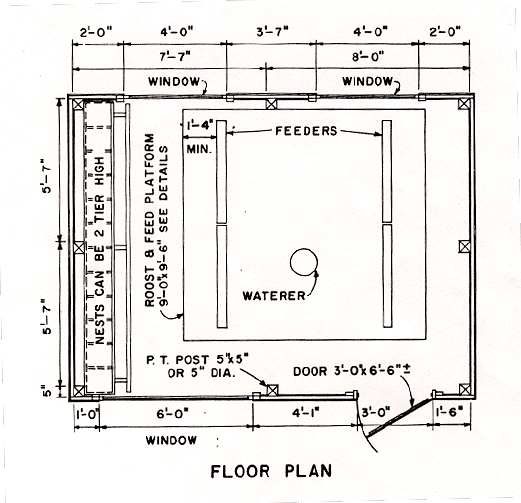
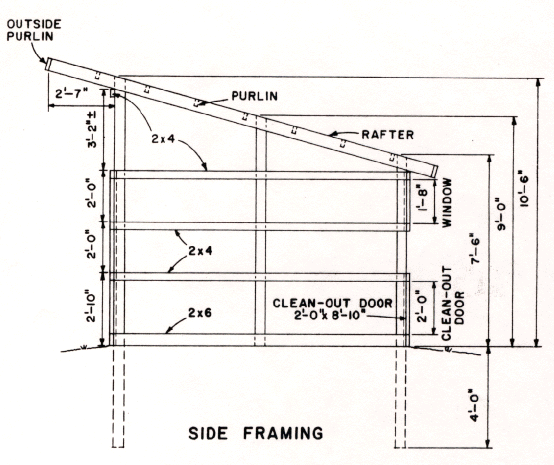
Plan for a 20’ x 20’ Layer House
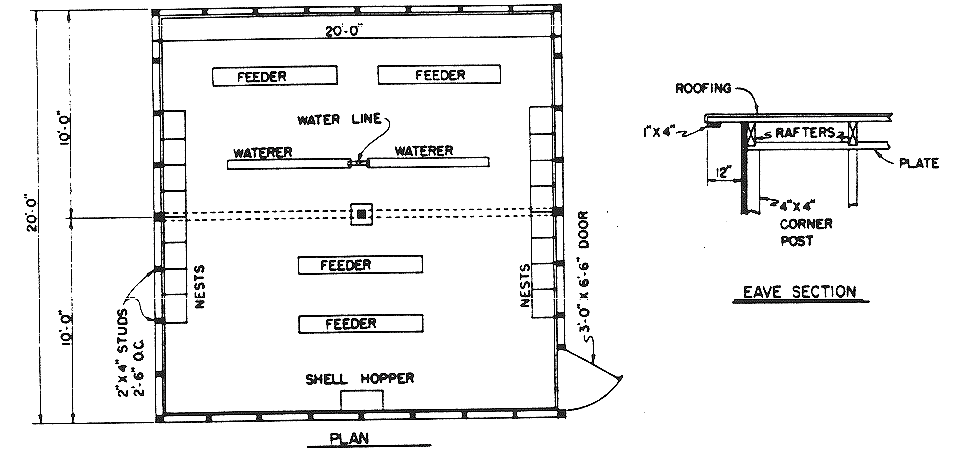
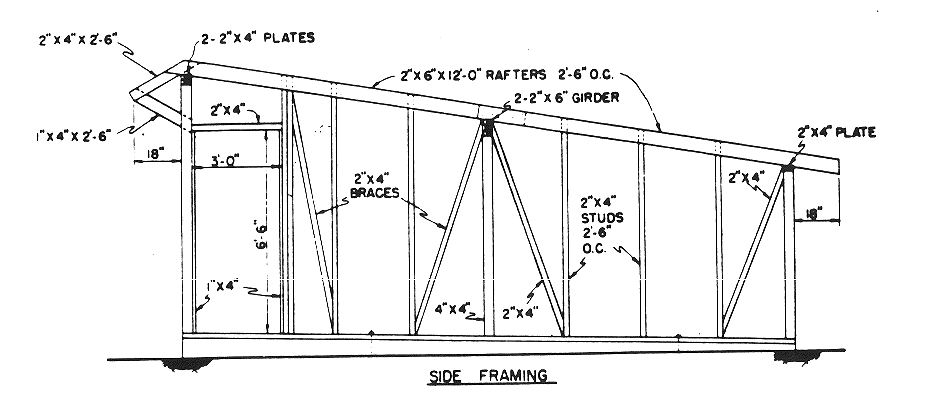

Plan for an 8’ x 8’ Layer House - 15 to 20 Hens
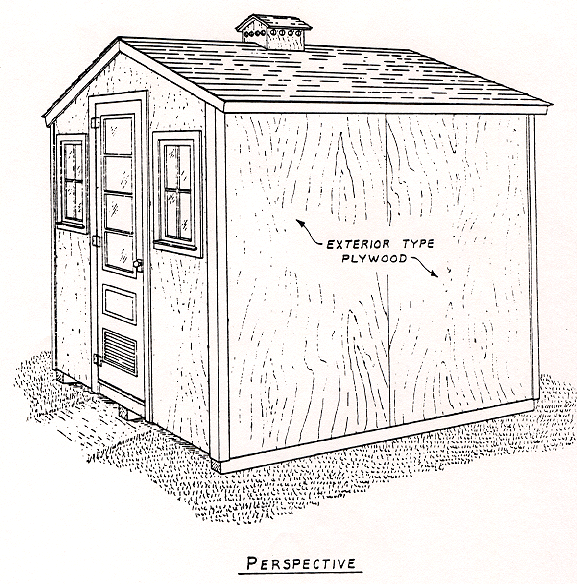

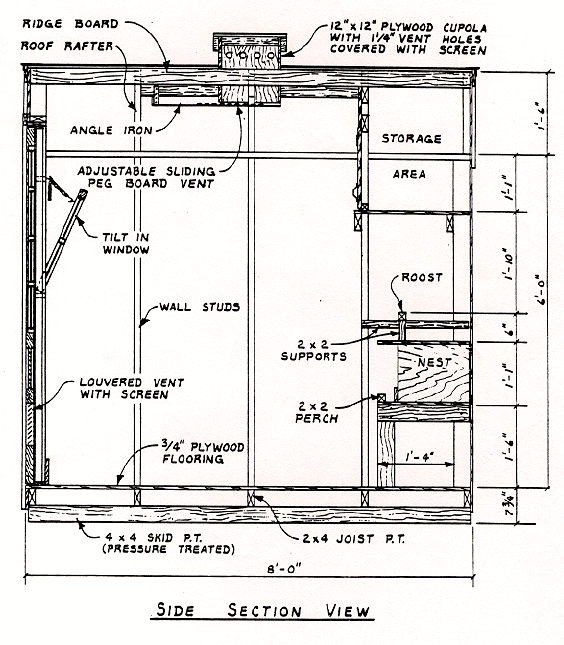
Small scale poultry coops seem to be built in almost every possible shape and size. Those building a new coop often ask for plans for the perfect chicken coop. However, few plans for small poultry houses are available. Many existing buildings can easily be adapted to accommodate poultry. Poultry housing can be as crude or elaborate as you wish to build as long as you provide the following:
1. Protection:
A good poultry house protects the birds from the elements (weather), predators, injury and theft. Poultry require a dry, draft-free house. This can be accomplished by building a relatively draft free
house with windows and/or doors which can be opened for ventilation when necessary. Build the coop
on high, well-drained areas. This prevents prolonged dampness and water saturation of the floor of the
coop and outside runs. Face the front of the coop, the windows and outside run to the south which
allows the sun to warm and dry the coop and soil. Allowing an adequate level of space per bird also
helps keep the humidity level in the coop to a minimum.
Keeping poultry totally confined to together with fence and covered runs are your best protection from predators. If you are building a new facility, consider laying a concrete floor, and start the wall with one or two concrete blocks. This prevents rodents, snakes, and predators from digging under the walls and the floors. Windows and doors must be securely covered with heavy-gauge mesh wire or screening
when opened.
With outside runs, bury the wire along the pen border at least 12" deep, and toe the fence outward about
6 inches. This stops most predators from digging under the fence. Animals always dig at the base of a
fence. By toeing the fence outward and burying it, the predator digs down right into more fencing. Some
people run electric fencing around the outside of their pens 4" off the ground about one foot from the
main fence to discourage predators. If your outside runs are not predator-proof, you need to lock up your
poultry before dark.
To prevent problems with hawks and owls, cover your outside runs with mesh wire or netting. A good ground cover of millet, broomcorn, sorghum or other tall leafy vegetation also provides cover for the birds to hide under. Many times a 3-4 ft. grid over the pen constructed of boiling twine will give excellent protection from flying predators.
To protect the birds from theft, lock your building and pens securely whenever you are not home. Have your neighbors watch for visitors while you are away. Some people actually have burglar alarms in their bird coops. A protective dog kept near your coop usually works well to discourage predators and unwanted visitors.

2. Adequate Space:
Birds need adequate space for movement and exercise as well as areas to nest and roost. Space requirements vary with the type of bird you raise.
Pigeons require a minimum of 4 square feet per breeding pair. One-eighth inch perch and two 9 inch x
9 inch nests per breeding pair are recommended.
Minimum Space Requirements
Type of Bird
Sq ft/bird inside
Sq ft/bird outside runs
Bantam Chickens
Laying Hens
Large Chickens
Quail
Pheasant
Ducks
Geese
1
1.5
2
1
5
3
6
4
8
10
4
25
15
18
1.5
2
1
5
3
6
4
8
10
4
25
15
18
Perches: With chickens, always provide 6 to 10 inches of perch space per bird. Perches are not usually used with meat chickens and waterfowl.
Nests: Always provide at least one nest for every 4-5 females in the flock.
3. Easy Access to Feed and Water:
Feeders and waters should be placed conveniently throughout the pen for birds' access. Place the bottom of the waters and top lip of the feeders at the birds' back height. This will keep the feed and water
clean and prevent wastage.
Small birds like pigeons, bantams and quail, only require 1 linear inch/bird of feeder and water space and large birds require 2-3 linear inches/bird.
When possible, place the waterier in the outside runs, especially for waterfowl. This helps to keep the humidity level lower inside the coop.
4. Source of Light:
If you wish to produce eggs from your flock year-round, you must have a source for electric light. One electric light every 40 feet at ceiling height is appropriate. Most small poultry houses do very well with one light above the feeding and watering area.
Windows placed on the south side of the coop will also be a good source of light and warmth in winter and a good source of ventilation in summer.
5. Ventilation:
Ample air movement without a draft is essential. Fresh air brings in oxygen while excess moisture, ammonia or carbon dioxide are removed the stale air moves out of the house. Dampness and ammonia build-up are a sign that there is not enough ventilation. For small coops windows or vents on one side of the house usually provide plenty of ventilation. Well-ventilated houses must also have plenty of insulation and a good vapor barrier. Failure to insulate or ventilate properly causes moisture to accumulate on the walls and ceiling in cool weather. Poultry can handle cold very well if they are dry. However, cool and humid conditions can create many health problems. Locate openings on the side away from prevailing winds. The south or east side is usually best.
6. Appearance:
The appearance of any poultry house or outside run that is visible to the neighborhood should never detract from the over-all appearance of the surroundings. Exteriors of structures should be kept painted and well-maintained. Weeds and trash should be removed from around all facilities. Proper landscaping can provide screening and also help muffle sounds from the birds. Unsightly structures are not good for the image of bird raising and may lead to new laws restricting the raising of birds in your area.
7. Use Common Sense:
When building a poultry house, use common sense in designing the structure. Build the roof high
enough and situate such permanent structures as nests, roosts, and feeders for easy access and to make it
easier to clean all areas of the house. Install doors so that they open inward. Using sliding windows so
that the birds cannot roost on them rather than windows which swing in or out. Use building materials
which will be easy to clean and disinfect. Slightly sloping the floor toward the door can help prevent
puddling in the building and will make the building easier to spray out and dry between uses.
Designs for Small Poultry Structures
The following are some designs of a few small poultry structures. However, remember, most existing structures can easily be adapted to accommodate a small poultry flock.
Plan No. 6188, 50 to 80 Layers
4


Plan for a 20’ x 20’ Layer House



Plan for an 8’ x 8’ Layer House - 15 to 20 Hens





 I enjoy helping others!
I enjoy helping others!